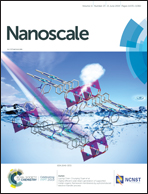Predicting two-dimensional semiconducting boron carbides†
Abstract
Carbon and boron can mix to form numerous two-dimensional (2D) compounds with strong covalent bonds, yet very few possess a bandgap for functional applications. Motivated by the structural similarity between graphene and recently synthesized borophene, we propose a new family of semiconducting boron carbide monolayers composed of B4C3 pyramids and carbon hexagons, denoted as (B4C3)m(C6)n (m, n are integers) by means of the global minimum search method augmented with first-principles calculations. These monolayers are isoelectronic to graphene yet exhibit increased bandgaps with decreasing n/m, due to the enhanced localization of boron multicenter bonding states as a consequence of the electronic transfer from boron to carbon. In particular, the B4C3 monolayer is even more stable than the previously synthesized BC3 monolayer and has a direct bandgap of 2.73 eV, with the promise for applications in optical catalysis and optoelectronics. These results are likely to inform the on-going effort on the design of semiconducting 2D materials based on other light elements.



 Please wait while we load your content...
Please wait while we load your content...